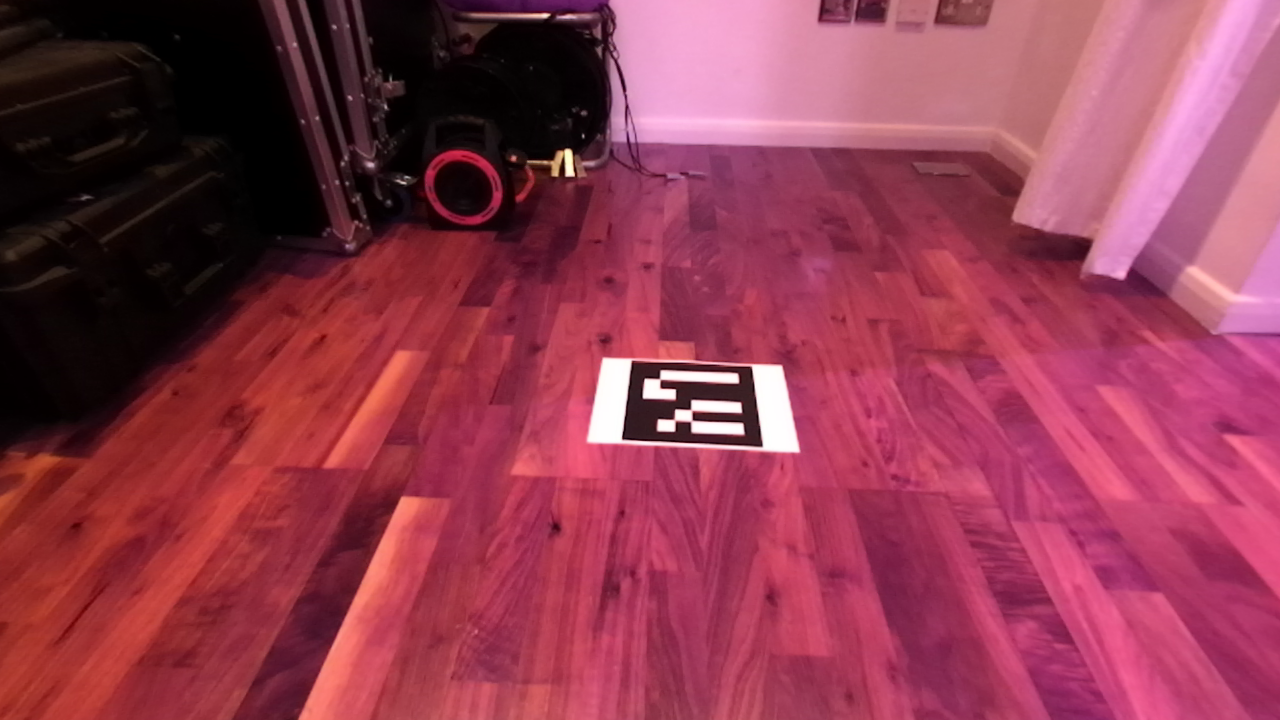OpenCv SolvePnp result, to Eigen Quaternion
I am running opencv solvePnP using 3d points that I am passing in manually, and 2d image points from the corner of an aruco marker.
my 4 x 2d, and 4 x 3d points are as follows:
2d: [631.811, 359.303]
2d: [750.397, 364.894]
2d: [761.65, 448.106]
2d: [621.837, 440.352]
3d: [2.73788, -2.19532, 119.784]
3d: [-18.8274, -3.25251, 119.167]
3d: [-17.7176, -15.5556, 101.448]
3d: [3.84767, -14.4984, 102.065]
my camera matrix is:
[657.0030186215286, 0, 646.6970647943629;
0, 657.0030186215286, 347.1175117491306;
0, 0, 1]
When I run this, I get rvec and tvec:
rot: [3.542907682527767e-08;
9.321253763995684e-10;
3.141592612624269]
tran: [-2.599387317758439e-06;
7.428777431217353e-07;
-1.306287668720693e-06]
Already, this looks strange. Please see the image attached for an example of where the marker is in relation to the camera. Then, i run the rvec and tvec through a function to get the camera pose in relation to the marker as an Eigen::quaterniond
void GetCameraPoseEigen(cv::Vec3d tvecV, cv::Vec3d rvecV, Eigen::Vector3d &Translate, Eigen::Quaterniond &quats)
{
Mat R;
Mat tvec, rvec;
tvec = DoubleMatFromVec3b(tvecV);
rvec = DoubleMatFromVec3b(rvecV);
cv::Rodrigues(rvec, R); // R is 3x3
R = R.t(); // rotation of inverse
tvec = -R*tvec; // translation of inverse
Eigen::Matrix3d mat;
cv2eigen(R, mat);
Eigen::Quaterniond EigenQuat(mat);
quats = EigenQuat;
double x_t = tvec.at<double>(0, 0);
double y_t = tvec.at<double>(1, 0);
double z_t = tvec.at<double>(2, 0);
Translate.x() = x_t * 10;
Translate.y() = y_t * 10;
Translate.z() = z_t * 10;
}
The resulting quaternion is:
1.12774e-08 2.96705e-10 1 -2.04828e-08
Which is obviously wrong. But where is my mistake? Do my 2d - 3d correspondences look correct? Or is it my Eigen conversion?
Thank you.

EDIT:
I have adjusted the getCorners function based on the helpful comments below.
std::vector<cv::Point3f> getCornersInWorld(double side, cv::Vec3d rvec, cv::Vec3d tvec) {
//marker half size
double half_side = side / 2;
// compute rot_mat
cv::Mat rot_mat;
cv::Rodrigues(rvec, rot_mat);
// transpose of rot_mat
cv::Mat rot_mat_t = rot_mat.t();
//points in marker space
cv::Point3d cnr1(0, -half_side, half_side);
cv::Point3d cnr2(0, half_side, half_side);
cv::Point3d cnr3(0, half_side, -half_side);
cv::Point3d cnr4(0, -half_side, -half_side);
//to mat
cv::Mat cnr1Mat(cnr1);
cv::Mat cnr2Mat(cnr2);
cv::Mat cnr3Mat(cnr3);
cv::Mat cnr4Mat(cnr4);
//rotate points
cv::Mat pt_newMat1 = (-rot_mat_t * cnr1Mat);
cv::Mat pt_newMat2 = (-rot_mat_t * cnr2Mat);
cv::Mat pt_newMat3 = (-rot_mat_t * cnr3Mat);
cv::Mat pt_newMat4 = (-rot_mat_t * cnr4Mat);
// convert tvec to point
cv::Point3d tvec_3d(tvec[0], tvec[1], tvec[2]);
cv::Mat tvecMat(tvec_3d);
//rotate tvec
cv::Mat tvec_new = (-rot_mat_t * tvecMat);
cv::Point3d p(tvec_new);
//subtract tvec from all
pt_newMat1 = pt_newMat1 - tvec_new;
pt_newMat2 = pt_newMat2 - tvec_new;
pt_newMat3 = pt_newMat3 - tvec_new;
pt_newMat4 = pt_newMat4 - tvec_new;
//back to pnt
cv::Point3d p1(pt_newMat1);
cv::Point3d p2(pt_newMat2);
cv::Point3d p3(pt_newMat3);
cv::Point3d p4(pt_newMat4);
std::vector<cv::Point3f> retPnts;
retPnts.push_back(p1);
retPnts.push_back(p2);
retPnts.push_back(p3);
retPnts.push_back(p4);
return retPnts;
}
This gives me:
2d: [640.669, 489.541]
2d: [746 ...
How did you get those 3d points for the solvePnP? They aren't simple enough to draw conclusions from anything. Try setting them to z = 0, (x,y) whatever the offset is from the center of the marker to the corners.
Hi, thanks for your reply. I am getting the 3d points by running solvePnP once (using the aruco module), then extrapolating the 3d points in world space from the marker pose. The reason for this is that I need to have multiple markers in frame, randomly placed, and run solvePnP on them.
When I add the points manually, for this one marker, like this:
I get:
which looks correct. So I must have my 3d points wrong? Or have them in the wrong order?
std::vector<cv::point3f> getCornersInCameraWorld(double side, cv::Vec3d rvec, cv::Vec3d tvec) {
that is my function to get the world space corners from rvec and tvec. Thanks again!
I can't quite follow what's going on, but it doesn't look right. You definitely need all the information in the rotation matrix.
First, invert the rotation matrix
Second, rotate all the points, including the tvec.
Third, subtract the tvec from everything, which leaves the camera center at (0,0,0), and everything else positioned appropriately.
Thank you! To clarify, pt_old, above, is the pt (0, - halfmarkersize, halfmarkersize) etc? So basically, set the points as if the middle of the marker is 0, rotate them all with the rotation matrix, and subtract tvec. Is that right?
All the points you are interested in. You also need to do the same with tvec, and what you subtract is the tvec_new.
I have updated my code, and added to the question above. It looks better, but still not correct. If you have a moment, could you take a look over the new function please? Thank you again for your time!
Well, if the camera is (0,0,0), the marker points should all have a +z value. So if they're negative, something is wrong. I'll try to take a look later, depending on how much I get done.
Thank you again, I am still stuck on this.